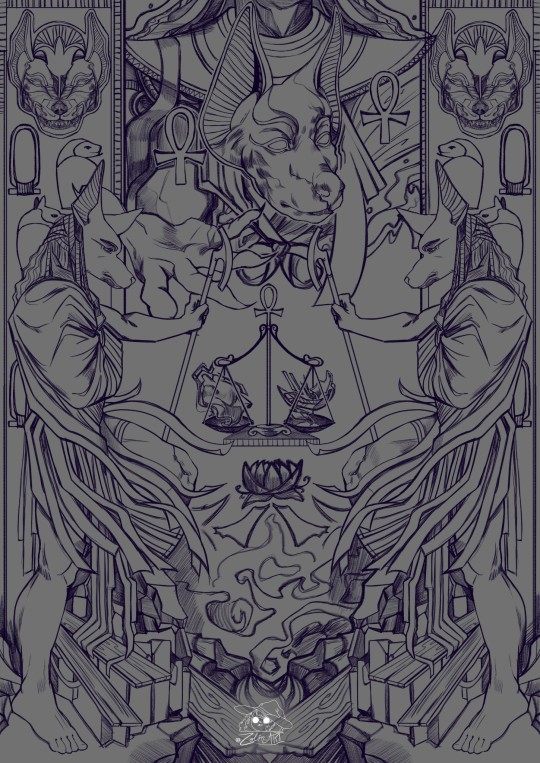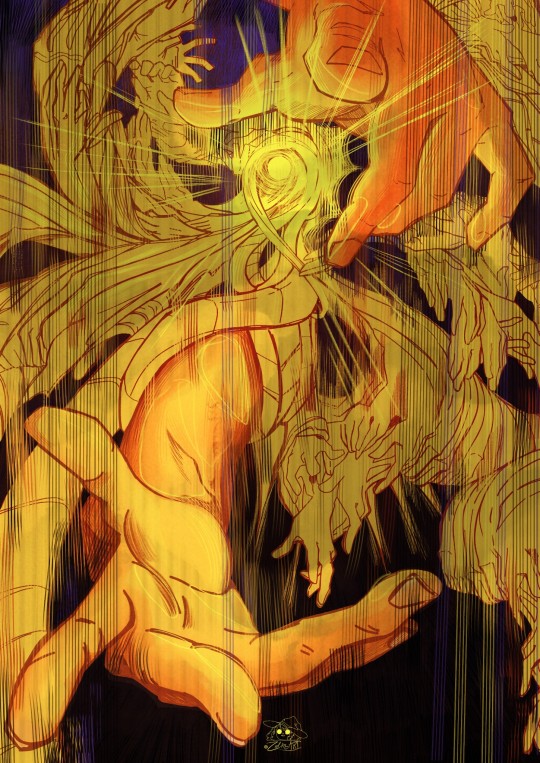#Amun
Explore tagged Tumblr posts
Text

Replica Cast Head of Zeus-Amun, Roman Period (about 100 CE), Liverpool World Museum
Zeus-Amun was a popular god in Ptolemaic and Roman Egypt. He is a combination of the Egyptian god Amun and the Greek god Zeus. He is usually shown with the ram's horns of Amun and the bearded face of Zeus. In 331 BCE Alexander the Great claimed he was told by an oracle that he was the son of Zeus-Amun.
#gods#head#zeus amun#archaeology#ancient living#ancient beliefs#history#deity#figure#ancient cultures#ancient crafts#metal#metalworking#zeus#amun#beliefs
477 notes
·
View notes
Text

He needed a face, figured I could share it u-u
Other deets:
cat person, has owned four. The last one is a stubborn tortoise calico named Patricia (carries around a locket with some of her fur)
"do you wanna see my collection of phoenix scales?" actually shows you phoenix scales, and occasionally varghest teeth ("they're so shiny!!")
knows the name of every mountain in the Free Marches
well informed on his children's whereabouts, yet he doesn't want to get involved in their lives
falls in and out of love very rapidly. Longest relationship he had was with Amun's mother (one month)
#dragon age#elves#ankh#amun#no name for now because there's a reveal lmao#ndo sta l'art tag#he's not a bad guy he's just a terrible dad#except when it comes to cats
85 notes
·
View notes
Text

Old sketches of Amun and Ptah
91 notes
·
View notes
Photo

The Kingdom of Kush
Kush was a kingdom in northern Africa in the region corresponding to modern-day Sudan. The larger region around Kush (later referred to as Nubia) was inhabited c. 8,000 BCE but the Kingdom of Kush rose much later. The Kerma Culture, so named after the city of Kerma in the region, is attested as early as 2500 BCE and archaeological evidence from Sudan and Egypt show that Egyptians and the people of Kush region were in contact from the Early Dynastic Period in Egypt (c. 3150 - c. 2613 BCE) onwards. The later civilization defined as 'Kushite' probably evolved from this earlier culture but was heavily influenced by the Egyptians.
While the history of the overall country is quite ancient, the Kingdom of Kush flourished between c. 1069 BCE and 350 CE. The New Kingdom of Egypt (c. 1570-1069 BCE) was in the final stages of decline c. 1069 BCE, which empowered the Kushite city-state of Napata. The Kushites no longer had to worry about incursions into their territory by Egypt because Egypt now had enough trouble managing itself. They founded the Kingdom of Kush with Napata as its capital, and Kush became the power in the region while Egypt floundered.
Kushite kings became the pharaohs of Egypt's 25th Dynasty and Kushite princesses dominated the political landscape of Thebes in the position of God's Wife of Amun. The Kushite king Kashta (c. 750 BCE) was the first to establish himself on the Egyptian throne and appointed his daughter, Amenirdis I, the first Kushite God's Wife of Amun. He was followed by other great Kushite kings who reigned until the Assyrian invasion of Egypt by Ashurbanipal in 666 BCE.
In c. 590 BCE Napata was sacked by the Egyptian pharaoh Psammeticus II (595-589 BCE) and the capital of Kush was moved to Meroe. The Kingdom of Kush continued on with Meroe as its capital until an invasion by the Aksumites c. 330 CE which destroyed the city and toppled the kingdom. Overuse of the land, however, had already depleted the resources of Kush and the cities would most likely have been abandoned even without the Aksumite invasion. Following this event, Meroe and the dwindling Kingdom of Kush survived another 20 years before its end c. 350 CE.
Sponsorship Message
This article was sponsored by Total War™
Total War: ROME II – Desert Kingdoms is a Culture Pack DLC released on March 8th, 2018. Pre-order now to get 10% off. Full faction details available on Steam. Learn More
.sponsor.ca h3 { text-transform: none; margin-top: 0px; margin-bottom: 15px; font-family: "Libre Baskerville", "Palatino Linotype", "Book Antiqua", Palatino, serif; } .sponsor.ca .ca_logo { width: 100px !important; height: 46px; float: right; box-shadow: none; margin: 0; } .sponsor_message { margin-left: 280px; font-family: Karla, Arial, Helvetica, sans-serif; line-height: 140%; } .sponsor.ca { padding: 10px 0px 25px 0px; margin: 25px 0px; border-top: 1px dotted #dadada; border-bottom: 1px dotted #dadada; } .sponsor_message .big_red_button { margin-top: 13px; } .sponsor.ca .key_art { margin-top: 0px; margin-bottom: 10px; width: 260px; height: auto; float: left; } .sponsor h4 { font-weight: normal; text-transform: uppercase; color: silver; margin-bottom: 10px; margin-top: 0px; font-family: Karla,Arial,Helvetica,sans-serif; font-size: 13px; padding: 0; } @media (max-width: 1199px) { .sponsor.ca .key_art { float: none; width: 100%; } .sponsor.ca .sponsor_message { margin-left: 0px; } .sponsor.ca h3 { margin-top: 20px; margin-bottom: 10px; } } @media (max-width: 767px) { }
Continue reading...
27 notes
·
View notes
Text
VERY important video
That I should totally reupload
28 notes
·
View notes
Text
oc art dumpppp




bunch of smooches and a cuddle

see it's funny because he is also a busy idol
#my art#full art#sketch dump#my ocs#tadao#ryunosuke#taryun#ichigo#kyo#kyochi#keizer#amun#keimun#taiki#rokuro#kotoya#taikoturo#shouhei#nobu (as a cookie...)#nobuhei#ishindenshin#grimm parade#cheer4u
31 notes
·
View notes
Text
Dua Amun-Ra!
He who is the unseen and the seen
You rise as the golden one
Your warmth embraces me
You kiss me as the breeze
You create the land, none comes before you
Your majesty cannot be defeated
You fill my nose with the breath of life
You are the ruler of eternity
You drive out all evil
Your light strengthens me
Your presence fills me
I am overtaken with awe of you
#Naru writes#prayer#kemetic polytheism#kemetic#kemetic paganism#kemeticism#kemetism#kemetic fandom#Amun-Ra#Amun Ra#Amun#god amun#Ra#Re#kemetic prayer#pagan prayer#deity worship#polytheism
40 notes
·
View notes
Text

King Ptolemy makes offerings to the Theban triad: Amun, Mut and Khons, as well as the falcon-headed Montu.
59 notes
·
View notes
Text





Egyptian Gods; Amun-Amunet, Anubis, Aten, Bastet and Medjed
5 complete and still need 29 Illustrations to finish this serie, probably I'm gonna die before to finish it but I'm gonna find out in the middle of the road or sm
#digital art#digital drawing#ilustración digital#egyptian mythology#egyptian gods#ancient god#aten egyptian god#bastet#Anubis#Amun#amunet#medjed
85 notes
·
View notes
Text


Amun, the Primordial God of the Invisible, is the former leader of the Ogdoad, a group of eight chaos deities which fought against Ra during the Time of Creation. Generous and Righteous, Amun decided to ally himself with the Sun God becoming one of his strongest allies against the forces of darkness. Associated with victory and kingship, he is the fierce protector of the weak and poor. With his divine spouse Mut and their son Khonsu, they form the Theban Triad, one of the strongest and most beloved ones of Kemet.
54 notes
·
View notes
Text





#genshin impact#nahida#fanart#redesign#sumeru#genshin fanart#nabu malikata#king deshret#greater lord rukkhadevata#rukkhadevata#pushpavatika#al-ahmar#amun#buer
40 notes
·
View notes
Text

Kandake, kadake or kentake (Meroitic: 𐦲𐦷𐦲𐦡 kdke), often Latinised as Candace (Ancient Greek: Κανδάκη, Kandakē), was the Meroitic term for the sister of the king of Kush who, due to the matrilineal succession, would bear the next heir, making her a queen mother.

Pliny writes that the "Queen of the Ethiopians" bore the title Candace, and indicates that the Ethiopians had conquered ancient Syria and the Mediterranean.
In 25 BC the Kush kandake Amanirenas, as reported by Strabo, attacked the city of Syene, today's Aswan, in territory of the Roman Empire; Emperor Augustus destroyed the city of Napata in retaliation.
Cassius Dio wrote that Kandake's army advanced as far as the Elephantine in Egypt, but Petronius defeated them and took Napata, their capital, and other cities.
Four African queens were known to the Greco-Roman world as the "Candaces": Amanishakheto, Amanirenas, Nawidemak, and Malegereabar

Biblical usage
The Baptism of Queen Candace's Eunuch (c. 1625–30, attributed to Hendrick van Balen and Jan Brueghel the Younger)
In the New Testament, a treasury official of "Candace, queen of the Ethiopians", returning from a trip to Jerusalem, met with Philip the Evangelist:
Now an angel of the Lord said to Philip, "Rise and go toward the south to the road that goes down from Jerusalem to Gaza." This is a desert place. And he rose and went. And there was an Ethiopian, a eunuch, a court official of Candace, queen of the Ethiopians, who was in charge of all her treasure. He had come to Jerusalem to worship
He discussed with Philip the meaning of a perplexing passage from the Book of Isaiah. Philip explained the scripture to him and he was promptly baptised in some nearby water. The eunuch 'went on his way, rejoicing', and presumably therefore reported back on his conversion to the Kandake

Evidence outside of Nubia that shows additional links to Kushite's queenship concept are found in Ethiopia. Ethiopia has a long dynastic history claimed to be over three millennia from before 1000 BC to 1973, the year of the overthrow of the last Menelik emperor, Haile Selassie. The Ethiopian monarchy's official chronicle of dynastic succession descends from Menelik I includes six regnant queens referred to as Kandake. The following queens from the king list have "Kandake" added to their name:
Nicauta Kandake (r. 740–730 BCE)
Nikawla Kandake II (r. 342–332 BCE)
Akawsis Kandake III (r. 325–315 BCE)
Nikosis Kandake IV (r. 242–232 BCE)
Nicotnis Kandake V (r. 35–25 BCE)
Garsemot Kandake VI (r. 40–50 CE) – Allegedly the queen who ruled at the time of the Biblical story of the Ethiopian eunuch.
Twenty-one queens are recorded as sole regent in the kingdom of Ethiopia until the 9th century CE. The conquest of Meroe by the Axumite King Ezana may well provide the historical fiction for the Ethiopian dynastic claim to the Nubian Kandakes and their kings, as it was from this point onwards that the Axumites began calling themselves "Ethiopians", a Greco-Roman term previously used largely for the ancient Nubians. For example, Makeda, Queen of Sheba, in the Kebra Nagast, is also recognized as Candace or "Queen Mother".

Alexandrian legend
Jewellery of Kandake Amanishakheto, from her tomb
A legend in the Alexander romance claims that "Candace of Meroë" fought Alexander the Great. In fact, Alexander never attacked Nubia and never attempted to move further south than the oasis of Siwa in Egypt. The story is that when Alexander attempted to conquer her lands in 332 BC, she arranged her armies strategically to meet him and was present on a war elephant when he approached. Having assessed the strength of her armies, Alexander decided to withdraw from Nubia, heading to Egypt instead. Another story claims that Alexander and Candace had a romantic encounter.
These accounts originate from Alexander Romance by an unknown writer called Pseudo-Callisthenes, and the work is largely a fictionalized and grandiose account of Alexander's life. It is commonly quoted, but there seems to be no historical reference to this event from Alexander's time. The whole story of Alexander and Candace's encounter appears to be legendary.
John Malalas has mixed the Pseudo-Callisthenes material with other and wrote about the affair of Alexander with Kandake, adding that they got married. Malalas also wrote that Kandake was an Indian queen and Alexander met her during his Indian campaign

List of ruling kandakes
Pyramid of Amanitore in modern day Sudan
See also: List of monarchs of Kush
At least eleven kandakes also ruled in their own right as monarchs (i.e. queen regnants) of Kush:
Nahirqo (middle 2nd century BC)
An unknown queen regnant (end of the 2nd–first half of the 1st century BC)
Amanirenas (end of the 1st century BC–beginning of the 1st century AD)
Amanishakheto (early 1st century AD)
Shanakdakhete (first half of the 1st century AD)
Nawidemak (first half of the 1st century AD?)
Amanitore (middle 1st century AD)
Amanikhatashan (middle 2nd century AD?)
Amanikhalika (second half of the 2nd century AD)
Patrapeamani [de] (early 4th century)
Amanipilade (mid-4th century)
Based on the reading of a single inscription, some lists give two later kandakes named Maloqorebar (266–283 AD) and Lahideamani (306-314 AD). A recently discovered inscription corrects this earlier reading, however, showing that neither was a woman.

Archaeological sources
The Kandakes of Meroe were first described through the Greek geographer's Strabo account of the "one-eyed Candace" in 23 BCE in his encyclopedia Geographica. There are at least ten regnant Meroitic queens during the 500 years between 260 BCE and 320 CE, and at least six during the 140 periods between 60 BC and 80 AD. The iconographic portrayal of the Meroitic queens depicts them as women often alone and at the forefront of their stelae and sculptures and shown in regal women's clothing. Early depictions of Kushite queens typically do not have Egyptian elements making their appearance drastically different from their Kushite men and Egyptian counterparts. As seen in the Dream Stela of Tanawetamani, a large shawl was wrapped around the body with an additionally decorated cloak worn over the first; typically, a small tab-like element hanging below the hem touches the ground and has been interpreted as a little tail. The first association with this element of dress is with Tarharqo's mother during his coronation ceremony.
It was not until George Reisner excavated the royal cemeteries at El Kurru and Nuri that archaeological material became available to study the Kushite queenship. Additionally, a few royal tombs of Kushite women have been found at Meroe's cemetery and in Egypt at Abydos (Leahy 1994). At El Kurru, six pyramids belong to royal women of the 25th Dynasty and a pyramid for queen Qalhata of the Napatan period. At Nuri, the tombs of royal women are located on the west plateau with more inscriptional information available at the site, linking the roles that the kings' mothers played in succession and their importance during the Kushite dynasty.
The most important event that Kushite women participated in was kingship's ensured continuity, where royal women were mentioned and represented in the royal ceremony. The lunettes of the stelae of Tanawetamani, Harsiyotef, and Nastasen all provide iconographic and textual evidence of these kings' enthronement. In all of these stelae, the king is accompanied by a female member of his family, mother, and wife. The king's mother played an essential role in the legitimacy of her son as the king; textual evidence from Taharqo's coronation stelae represents inscriptional evidence suggesting that the king's mother traveled to her son's coronation. During the Kushite 25th Dynasty, the office that is known as God's Wife of Amun was established. The royal women in this role acted as the primary contact with the Kushite god Amun. They played a decisive role in the king's accession to the throne.
Bas-reliefs dated to about 170 B.C. reveal the kentake Shanakdakheto, dressed in armor and wielding a spear in battle. She did not rule as queen regent or queen mother, but as a fully independent ruler. Her husband was her consort. In bas-reliefs found in the ruins of building projects she commissioned, Shanakdakheto is portrayed both alone as well as with her husband and son, who would inherit the throne by her death.

#african#afrakan#kemetic dreams#africans#brownskin#brown skin#afrakans#african culture#afrakan spirituality#ta seti#north africa#kandake#candace#kemet#nile valley#hapi valley#hapi#east africa#north east africa#Napata#african history#africantumblr#Shanakdakheto#Kushite 25th Dynasty#haile selassie#amun#amun ra#amunet#Kebra Nagast#meroe
30 notes
·
View notes
Text



Everyday by Buddy Holly plays muffled in the background
#sketches#dragon age#inquisitor lavellan#ankh#cullen rutherford#cullavellan#hawke#kerry#fenris#fenhawke#dragon age oc#shaan#amun#primula#krapfen#ndo sta l'art tag#drawing multiple characters means the longest list of tags <<#babysitting is shaan's accessory job
47 notes
·
View notes
Text
Absolutely love Amun's little dig at Aro in Breaking Dawn. Aro's all "Oh it's been so long since you came to visit me!"
And Amun just deadpans "Time means little; I never notice its passing."
Like lol imagine being so young you still notice centuries passing. Friendly reminder that I'm the oldest vampire on the planet and you 3,000-year-old whippersnappers best not forget it 😌
28 notes
·
View notes
Photo

The gods and goddesses of Ancient Egypt were an integral part of the people's everyday lives for over 3,000 years. There were over 2,000 deities in the Egyptian pantheon, many whose names are well known - Isis, Osiris, Horus, Amun, Ra, Hathor, Bastet, Thoth, Anubis, and Ptah among others - but many more less so who were also important. The more famous gods became state deities while others were associated with a specific region or, in some cases, a ritual or role. The goddess Qebhet, for example, is a little known deity who offered cool water to the souls of the dead as they awaited judgment in the afterlife, and Seshat was the goddess of written words and specific measurements overshadowed by Thoth, the better known god of writing and patron of scribes. Ancient Egyptian culture grew out of an understanding of these deities and the vital role they played in the immortal journey of every human being. Historian Margaret Bunson writes: The numerous gods of Egypt were the focal points of the nation's cultic rites and personal religious practices. They also played a part in the great mortuary rituals and in the Egyptian belief in posthumous eternal bliss. (98) The gods evolved from an animistic belief system to one which was highly anthropomorphic and imbued with magic. Heka was the god of magic and medicine but was also the primordial force, pre-dating all the other gods, who enabled the act of creation and sustained both mortal and divine life. The central value of the Egyptian culture was ma'at - harmony and balance - represented by the goddess of the same name and her white ostrich feather, and it was Heka who empowered Ma'at just as he did all the other deities. Heka was the manifestation of heka (magic) which should be understood to be natural laws which today would be considered supernatural but, to the Egyptians, were simply how the world and the universe functioned. The gods provided people with all good gifts but it was heka which allowed them to do so. These gods all had names, individual personalities and characteristics, wore different kinds of clothing, held different objects as sacred, presided over their own domains of influence, and reacted in highly individualistic ways to events. Each deity had their own area of expertise but were often associated with several spheres of human life. Hathor, for example, was a goddess of music, dancing, and drunkenness but was also understood as an ancient Mother Goddess, also associated with the Milky Way as a divine reflection of the Nile River, and, in her earlier incarnation as Sekhmet, as a destroyer. The goddess Neith was originally a war goddess who became the epitome of the Mother Goddess, a nurturing figure, to whom the gods would turn to settle their disputes. Many gods and goddesses, such as Set or Serket, transformed through time to take on other roles and responsibilities. These transformations were sometimes dramatic, as in the case of Set who went from a hero protector-god to a villain and the world's first murderer. Serket was almost certainly an early Mother Goddess, and her later role as protector against venomous creatures (especially scorpions) and guardian of women and children reflects those characteristics. Bunson writes: The Egyptians had no problem with a multitude of gods and they seldom shelved old deities in favor of new ones. Characteristics and roles of various gods were syncretized to reconcile differing religious beliefs, customs, or ideals. For political and religious reasons, for example, the Theban god Amun, who was considered the most powerful deity in the New Kingdom, was united with Ra, a sun god whose cult dated to the beginnings of Egypt. Worship of the gods of Egypt evolved over time as large cults developed on a local and then on a national scale. (99) The following list of the gods and goddesses of ancient Egypt is derived from numerous works on the subject which follow below in the bibliography. Every attempt has been made to create a comprehensive listing but minor regional deities have been omitted if their role seems uncertain or they were transformed into major gods. When a major god evolved from an earlier minor deity, it is noted. Included also are concepts, such as The Field of Reeds or Lily Lake, which were regions in the afterlife associated with the gods. The definitions of the god's characteristics and the roles they played are synthesized for clarity but it should be noted that not every deity listed was understood in the same way throughout Egypt's long history. Osiris, for example, was most likely a fertility god in the Predynastic Period of Egypt (c. 6000-3150 BCE) but was already understood as the First King by the Early Dynastic Period (c. 3150-2613 BCE) and was the most popular god in Egypt during the time of the New Kingdom (1570-1069 BCE) at the same time that Amun was considered King of the Gods. Although these developments are sometimes noted below, the gods are generally described in the roles they were best known for at the peak of their popularity.
#HistoryFacts#History#Thoth#Set(EgyptianGod)#Qebhet#Osiris#Nephthys#Neith#Ma'at#Isis#Horus#Heka#Hathor#EgyptianReligion#EgyptianMythology#Egypt#Bes#Bastet#Apophis#Apis#Anubis#Amun#WHE
27 notes
·
View notes
Text
Heart hidden away,
My legs are firmed.
My ba soars towards your rays,
My arms raise towards your light.
O' Amun-Re,
you thought me into being,
and your thought will bring me to the Duat.
16 notes
·
View notes